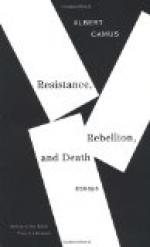For certain crimes mankind has ordained penalties of exceptional severity, in order to emphasise a general abhorrence. In Rome, for example, a parricide, or the murderer of any near relation, was thrown into deep water, tied up in a sack together with a dog, a cock, a viper, and a monkey, which were probably symbols of his wickedness, and must have given him a lively time before death supervened. Similarly, the English law, always so careful of domestic sanctitude in women, provided that a wife who killed her husband should be dragged by a horse to the place of execution and burnt alive. We need not recall the penalties considered most suitable for the crime of religious difference—the rack, the fire, the boiling oil, the tearing pincers, the embrace of the spiky virgin, the sharpened edge of stone on which the doubter sat, with increasing weights tied to his feet, until his opinions upon heavenly mysteries should improve under the stress of pain. When we come to rebellion, the ordinance of English law was more express. In the case of a woman, the penalty was the same as for killing her husband—that crime being defined as “petty treason,” since the husband is to her the sacred emblem of God and King. So a woman rebel was burnt alive as she stood, head, quarters, and all. But male rebels were specially treated, as may be seen from the sentence passed upon them until the reign of George III.[1] These were the words that Judge Jeffreys and Scroggs, for instance, used to roll out with enjoyable eloquence upon the dazed agricultural labourer before them:
“The sentence of the Court now is that you be conveyed from hence to the place from where you came, and from there be drawn to the place of execution upon hurdles; that you be hanged by the neck; that you be cut down alive; that your bowels be taken out and burnt in your view; that your head be severed from your body; that your body be divided into four quarters, and your quarters be at the disposition of the King: and may the God of infinite mercy be merciful to your soul. Amen.”
“Why all this cookery?” once asked a Scottish rebel, quoted by Swift. But the sentence, with its confiding appeal to a higher Court than England’s, was literally carried out upon rebels in this country for at least four and a half centuries. Every detail of it (and one still more disgusting) is recorded in the execution of Sir William Wallace, the national hero of Scotland, more generally known to the English of the time as “the man of Belial,” who was executed at Tyburn in 1305.[2] The rebels of 1745 were, apparently, the last upon whom the full ritual was performed, and Elizabeth Gaunt, burnt alive at Tyburn in 1685 for sheltering a conspirator in the Rye House Plot, was the last woman up to now intentionally put to death in this country for a purely political offence. The long continuance of so savage a sentence is proof of the abhorrence in which the crime of rebellion has been held. And in many minds the abhorrence still subsists. Sir James Fitzjames Stephen, for instance, one of our greatest authorities on criminal law, wrote in 1880:




